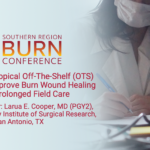Abstract | March 2, 2021
Evaluation of Topical Off-The-Shelf (OTS) Therapies to Improve Burn Wound Healing During Prolonged Field Care
Learning Objectives
- Compare burn wounds treated with OTS dressings to burns treated with PFC standard of care Silver sulfadiazine;
- Determine if re-epithelialization is greater at PBD 28 for OTS dressings as compared to standard of care;
- Conclude if any OTS dressings can improve wound healing in the PFC setting.
Introduction: Surgical debridement of injured service members is only permitted once the combat casualty arrives at a Role 4 level of care. While awaiting definitive treatment, wounds are at risk of infection and delayed healing. In order to address this gap in military medical care, several effective topical off-the-shelf (OTS) dressings have been identified that are either already FDA approved or in the approval processes and have far forward, field-deployable potential for use. The purpose of this study is to optimize combat burn wound care so that injured service members may not need evacuation to the burn clinic and combat power can be preserved.
Methods: Twelve deep-partial thickness burns will be created on the dorsum of anesthetized swine (Sus scrofa domestica) using a thermocoupled burn device at 100°C. One hour following burn, non-surgical debridement will be performed and either the OTS dressing or standard of care Silver sulfadiazine will be placed on the wound in order to simulate a prolonged field care (PFC) environment. Wounds will be assessed on post-burn days (PBD) 3, 7, 14, 21, and 28. Dressings are removed and replaced at each assessment. Assessments consist of digital photographs, 3-D photographs, laser speckle contrast imaging (LSCI), and biopsies for histology and colony-forming unit (CFU) count. Primary outcome will be percent reepithelialization on PBD 28.
Results: Experiments are currently ongoing and preliminary data will be presented during the meeting.
Conclusions: We hope to identify readily deployable OTS dressings that perform better than the current PFC treatments for battlefield burns during PFC scenarios.
References and Resources
- I.R. Driscoll, E.A. Mann-Salinas, N.L. Boyer, J.C. Pamplin, M.L. Serio-Melvin, J. Salinas, M.A. Borgman, R.L. Sheridan, J.J. Melvin, W.C. Peterson, J.C. Graybill, J.A. Rizzo, B.T. King, K.K. Chung, L.C. Cancio, E.M. Renz, Z.T. Stockinger, Burn Care, Joint Trauma System Clinical Practice Guidelines 12 (2016) 1-33.
- ABA, Burn Incidence and Treatment in the United States: 2016 Fact Sheet, American Burn Association, http://www.ameriburn.org/resources_factsheet.php, 2016.
- D.S. Kauvar, L.C. Cancio, S.E. Wolf, C.E. Wade, J.B. Holcomb, Comparison of combat and non-combat burns from ongoing U.S. military operations, J Surg Res 132(2) (2006) 195-200.
- E.M. Renz, L.C. Cancio, Acute Burn Care – Chapter 12, (2012) 593-638.
- P.Q. Bessey, B.D. Phillips, C.W. Lentz, L.S. Edelman, I. Faraklas, M.A. Finocchiaro, N.A. Kemalyan, M.B. Klein, S.F. Miller, M.J. Mosier, B.M. Potenza, C.L. Reigart, S.M. Browning, M.T. Kiley, J.A. Krichbaum, Synopsis of the 2013 annual report of the national burn repository, J Burn Care Res 35 Suppl 2 (2014) S218-34.
- R.D. Kearns, K.M. Conlon, A.L. Valenta, G.C. Lord, C.B. Cairns, J.H. Holmes, D.D. Johnson, A.F. Matherly, D. Sawyer, M.B. Skarote, S.M. Siler, R.C. Helminiak, B.A. Cairns, Disaster planning: the basics of creating a burn mass casualty disaster plan for a burn center, J Burn Care Res 35(1) (2014) e1-e13.

